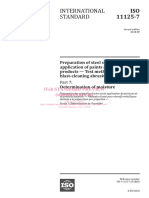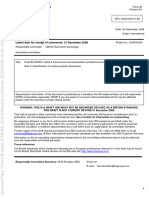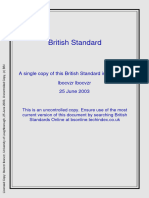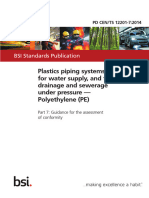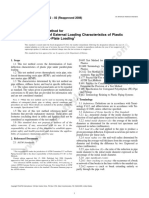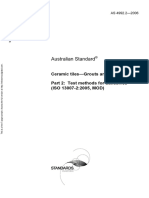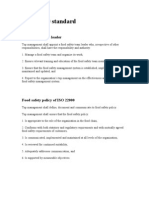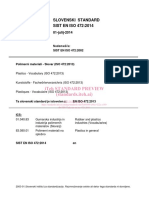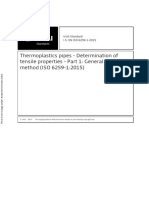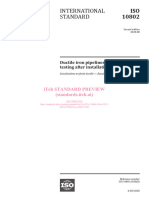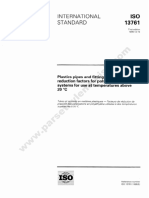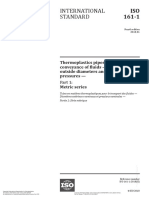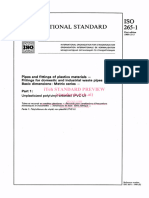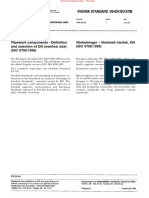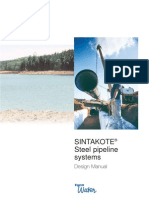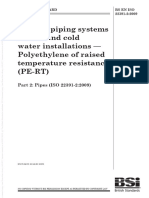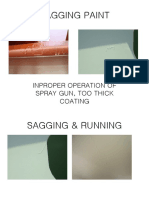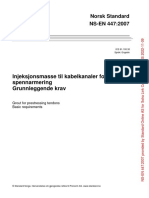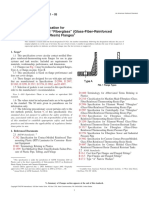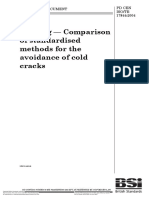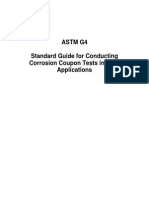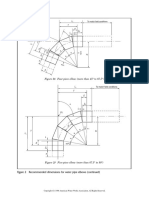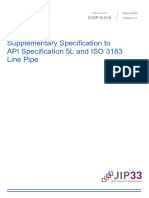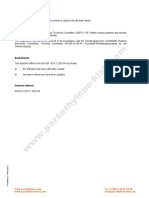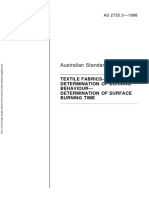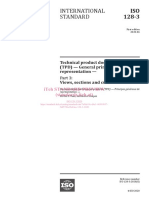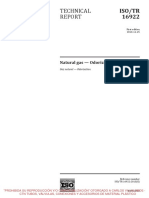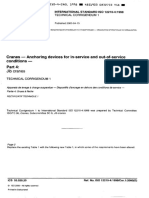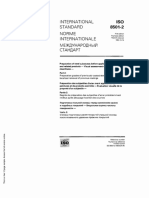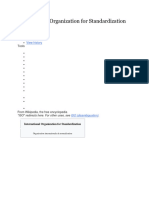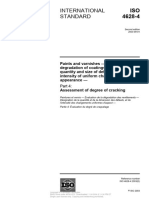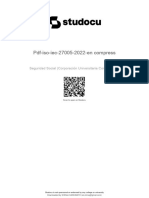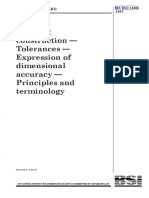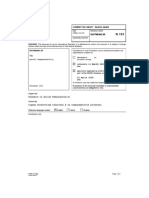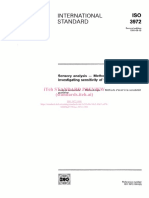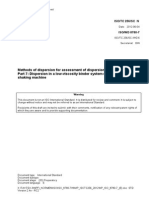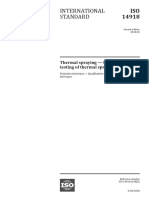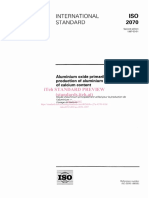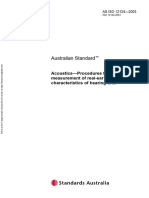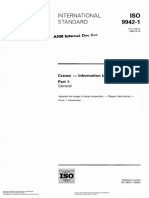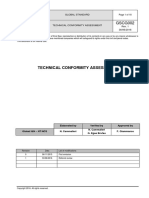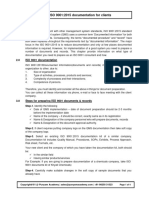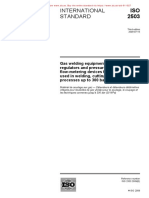Restrained Joint Systems For Ductile Iron Pipelines - Design Rules and Type Testing
Restrained Joint Systems For Ductile Iron Pipelines - Design Rules and Type Testing
Uploaded by
SrinuCopyright:
Available Formats
Restrained Joint Systems For Ductile Iron Pipelines - Design Rules and Type Testing
Restrained Joint Systems For Ductile Iron Pipelines - Design Rules and Type Testing
Uploaded by
SrinuOriginal Title
Copyright
Available Formats
Share this document
Did you find this document useful?
Is this content inappropriate?
Copyright:
Available Formats
Restrained Joint Systems For Ductile Iron Pipelines - Design Rules and Type Testing
Restrained Joint Systems For Ductile Iron Pipelines - Design Rules and Type Testing
Uploaded by
SrinuCopyright:
Available Formats
DRAFT INTERNATIONAL STANDARD ISO/DIS 10804
ISO/TC 5/SC 2 Secretariat: AFNOR
Voting begins on: Voting terminates on:
2009-06-26 2009-11-26
INTERNATIONAL ORGANIZATION FOR STANDARDIZATION • МЕЖДУНАРОДНАЯ ОРГАНИЗАЦИЯ ПО СТАНДАРТИЗАЦИИ • ORGANISATION INTERNATIONALE DE NORMALISATION
Restrained joint systems for ductile iron pipelines — Design
rules and type testing
Assemblages verrouillés pour canalisations en fonte ductile — Règles de conception et essai de type
[Revision of ISO 10804-1:1996]
ICS 23.040.01
Normen-Download-Beuth-Jindal Saw Ltd. Jindal Centre-KdNr.7507685-LfNr.4862019001-2010-04-08 12:19
In accordance with the provisions of Council Resolution 15/1993 this document is circulated in
the English language only.
Conformément aux dispositions de la Résolution du Conseil 15/1993, ce document est distribué
en version anglaise seulement.
To expedite distribution, this document is circulated as received from the committee secretariat.
ISO Central Secretariat work of editing and text composition will be undertaken at publication
stage.
Pour accélérer la distribution, le présent document est distribué tel qu'il est parvenu du
secrétariat du comité. Le travail de rédaction et de composition de texte sera effectué au
Secrétariat central de l'ISO au stade de publication.
THIS DOCUMENT IS A DRAFT CIRCULATED FOR COMMENT AND APPROVAL. IT IS THEREFORE SUBJECT TO CHANGE AND MAY NOT BE
REFERRED TO AS AN INTERNATIONAL STANDARD UNTIL PUBLISHED AS SUCH.
IN ADDITION TO THEIR EVALUATION AS BEING ACCEPTABLE FOR INDUSTRIAL, TECHNOLOGICAL, COMMERCIAL AND USER PURPOSES, DRAFT
INTERNATIONAL STANDARDS MAY ON OCCASION HAVE TO BE CONSIDERED IN THE LIGHT OF THEIR POTENTIAL TO BECOME STANDARDS TO
WHICH REFERENCE MAY BE MADE IN NATIONAL REGULATIONS.
RECIPIENTS OF THIS DRAFT ARE INVITED TO SUBMIT, WITH THEIR COMMENTS, NOTIFICATION OF ANY RELEVANT PATENT RIGHTS OF WHICH
THEY ARE AWARE AND TO PROVIDE SUPPORTING DOCUMENTATION.
© International Organization for Standardization, 2009
ISO/DIS 10804
PDF disclaimer
This PDF file may contain embedded typefaces. In accordance with Adobe's licensing policy, this file may be printed or viewed but shall
not be edited unless the typefaces which are embedded are licensed to and installed on the computer performing the editing. In
downloading this file, parties accept therein the responsibility of not infringing Adobe's licensing policy. The ISO Central Secretariat
accepts no liability in this area.
Adobe is a trademark of Adobe Systems Incorporated.
Details of the software products used to create this PDF file can be found in the General Info relative to the file; the PDF-creation
parameters were optimized for printing. Every care has been taken to ensure that the file is suitable for use by ISO member bodies. In the
unlikely event that a problem relating to it is found, please inform the Central Secretariat at the address given below.
Normen-Download-Beuth-Jindal Saw Ltd. Jindal Centre-KdNr.7507685-LfNr.4862019001-2010-04-08 12:19
Copyright notice
This ISO document is a Draft International Standard and is copyright-protected by ISO. Except as permitted
under the applicable laws of the user's country, neither this ISO draft nor any extract from it may be
reproduced, stored in a retrieval system or transmitted in any form or by any means, electronic, photocopying,
recording or otherwise, without prior written permission being secured.
Requests for permission to reproduce should be addressed to either ISO at the address below or ISO's
member body in the country of the requester.
ISO copyright office
Case postale 56 • CH-1211 Geneva 20
Tel. + 41 22 749 01 11
Fax + 41 22 749 09 47
E-mail copyright@iso.org
Web www.iso.org
Reproduction may be subject to royalty payments or a licensing agreement.
Violators may be prosecuted.
ii © ISO 2009 – All rights reserved
ISO/DIS 10804
Foreword
ISO (the International Organization for Standardization) is a worldwide federation of national
standards bodies (ISO member bodies). The work of preparing International Standards is
normally carried out through ISO technical committees. Each member body interested in a
subject for which a technical committee has been established has the right to be represented
on that committee. International organizations, governmental and non-governmental, in
liaison with ISO, also take part in the work. ISO collaborates closely with the International
Electrotechnical Commission (IEC) on all matters of electrotechnical standardization.
Draft International Standards adopted by the technical committees are circulated to the
member bodies for voting. Publication as an International Standard requires approval by at
least 75 % of the member bodies casting a vote.
International Standard ISO 10804 was prepared by Technical Committee ISO/TC 5, Ferrous
metal pipes and metallic fittings, Subcommittee SC2, Cast iron pipes, fittings and their joints.
This second edition cancels and replaces the first edition (ISO 10804 – 1; 1996) of which it
constitutes a technical revision and deletion of Part 1 from the title/numbering.
Normen-Download-Beuth-Jindal Saw Ltd. Jindal Centre-KdNr.7507685-LfNr.4862019001-2010-04-08 12:19
© ISO 2009 – All rights reserved iii
Normen-Download-Beuth-Jindal Saw Ltd. Jindal Centre-KdNr.7507685-LfNr.4862019001-2010-04-08 12:19
DRAFT INTERNATIONAL STANDARD ISO/DIS 10804
Restrained joint systems for ductile iron pipelines — Design
rules and type testing
1 Scope
This International Standard specifies the design rules and type testing for restrained joint
systems to be used on ductile iron pipelines complying with ISO 2531 and ISO 7186, in order
to determine their mechanical properties and leak tightness.
2 Normative references
The following standards contain provisions which, through reference in this text, constitute
provisions of this International Standard. At the time of publication, the editions indicated were
valid. All standards are subject to revision, and parties to agreements based on this
International Standard are encouraged to investigate the possibility of applying the most
recent editions of the standards indicated below. Members of IEC and ISO maintain registers
of currently valid International Standards.
ISO 2531: 1998, Ductile iron pipes, fittings and accessories for pressure pipelines
ISO 6708: 1995, Pipework components – Definition and selection of DN (nominal size).
ISO 7186: 1996, Ductile iron products for sewerage applications.
3 Definitions
For the purposes of this International Standard the definitions given in ISO 6708 and the
following definitions apply:
3.1 restrained joint
joint in which a means is provided to prevent separation of the assembled joint
3.2 allowable operating pressure (PFA)
Normen-Download-Beuth-Jindal Saw Ltd. Jindal Centre-KdNr.7507685-LfNr.4862019001-2010-04-08 12:19
maximum internal pressure, excluding surge, that a component can safely withstand in
permanent service.
3.3 allowable maximum operating pressure (PMA)
maximum internal pressure, including surge, that a component can safely withstand in
service.
3.4 allowable test pressure (PEA)
maximum hydrostatic pressure that a newly installed component can withstand for a relatively
short duration, when either fixed above ground level or laid and backfilled underground, in
order to measure the integrity and tightness of the pipeline.
NOTE This test pressure is different from the system test pressure, which is related to the design pressure of the
pipeline.
3.5 type test
proof of design test which is done once and is repeated only after change of design.
3.6 allowable angular deflection
angular deflection that a joint between two components can safely withstand in service under
the allowable operating pressure (PFA).
4 Design rules
4.1 All restrained joints for ductile iron pipes, fittings and other components shall be designed
with the requirements of this clause. If the design of a restrained joint has been tested and
successfully used for a minimum of ten years, a type test as described in clause 5 is only
© ISO 2009 – All rights reserved 1
ISO/DIS 10804
required for a significant change in the design which could adversely affect the performance
of the restrained joint.
4.2 The minimum thickness of the spigot for restrained joints shall be such as to allow any
necessary welding or loading from attachments (e.g. gasket teeth). This may result in pipe
thicker than the corresponding pressure class thickness of the pipe. The manufacturer shall
declare the pipe thickness for his restrained joints.
4.3 The design safety factors with respect to failure against axial forces due to internal
pressure shall be such that the joints shall withstand a type test of 1,5 times allowable
1)
operating pressure (PFA) plus 5 bar .
1)
1 bar = 105 N/m2 = 105 Pa = 0,1 MPa
4.4 The joints shall be type tested to a negative pressure of 0,9 bar below atmospheric
pressure (approximately 0,1 bar absolute pressure). When the restraining mechanism and
sealing component of a restrained joint are independent, such a joint does not need to be
subjected to a negative internal pressure test if the unrestrained version of the joint has
passed this test (ISO 2531).
4.5 The joints shall be type tested to a cyclic internal hydraulic pressure as follows:
a) 24,000 cycles
b) Test pressure between PMA and (PMA – 5) bar
4.6 Ductile iron pipelines and the restrained joints as defined in this International Standard are
well suited for use in seismic zones. However, certain locations, such as fault crossings,
liquefaction zones, connections to structures etc., require specialized designs. The pipe
manufacturer or a competent earthquake engineer should be consulted.
4.7 For joint restraint components, the protection against aggressive soils shall be at least as
good as that of the pipes and/or fittings. It may be achieved by means of works applied
coatings and/or site applied protection systems.
5 Type testing
Normen-Download-Beuth-Jindal Saw Ltd. Jindal Centre-KdNr.7507685-LfNr.4862019001-2010-04-08 12:19
5.1 General
Each restrained joint design shall be tested in order to demonstrate its mechanical strength
and its leak tightness under the most unfavourable conditions of castings tolerances and joint
movements.
The type tests shall be carried out in the configuration of maximum design radial gap between
the components to be jointed (smallest spigot together with largest socket). In addition, the
spigot thickness shall be the minimum casting thickness plus 10 %, minus 0 %. The length of
the minimum thickness of the spigot for the type test shall be such as to include any welding
and/or attachments for that joint. It is permissible to machine the spigot end of the test pipe in
the bore to achieve the required thickness.
In the type tests, the maximum gap shall not be less than the corresponding maximum design
radial gap by more than 5 % or 0,5 mm (whichever is the smaller). The internal socket
diameter may be machined to achieve this.
5.2 Test conditions
There shall be a type test for at least one DN for each of the groupings given in Table 1,
normally using the preferred DN. One DN is representative of a grouping when the
performances are based on the same design parameters throughout the size range.
2 © ISO 2009 – All rights reserved
ISO/DIS 10804
Table 1 DN groupings for type tests
DN 40 to 250 300 to 600 700 to 1000 1100 to 2000 >2000
groupings
Preferred 200 400 800 1600 2400
DN in each
grouping
If a grouping covers products of different designs and/or products manufactured by different
processes, the grouping shall be subdivided. If, for a certain manufacturer, a grouping
contains only one DN, this DN may be considered as part of the adjacent grouping provided
that it is of identical design and manufactured by the same process.
Each diameter tested shall be subjected to the following conditions:
a) joint assembled in the aligned position, then deflected to the allowable angular
deflection indicated in the manufacture’s instructions, and tested while
maintained in the deflected position;
b) joint assembled in the aligned position, then subjected to a load giving a
resultant shear force across the joint not less than 30 times DN (expressed in
newtons), and tested under shear.
All joint assemblies shall exhibit no visible leakage and no mechanical instability after 2 h
under:
1) hydrostatic pressure as given in 4.3;
2) negative internal pressure as given in 4.4;
3) cyclic internal hydraulic pressure as given in 4.5.
In addition, any axial movement that may occur at the joint shall reach a constant value within
the 2 h.
Normen-Download-Beuth-Jindal Saw Ltd. Jindal Centre-KdNr.7507685-LfNr.4862019001-2010-04-08 12:19
5.3 Test method for positive internal pressure
The testing apparatus shall be capable of providing suitable end closure whether the joint is in
the aligned position, or deflected, or subjected to a shear load. It shall be equipped with a
pressure gauge with an accuracy of ± 3 %.
The test shall be carried out on an assembled joint comprising two pipe sections, each at
least 1 m long.
For the test according to 5.2 b), the shear load shall be applied to the spigot end by means of
a V-shaped block with an angle of 120º, located at approximately 0,5 x DN, in millimetres, or
200mmm from the socket face (whichever is the larger); the socket shall bear on a flat
support.
The test assembly shall be filled with water and suitably vented. The test pressure shall be
raised at a rate not exceeding 1 bar/s.
The test pressure shall be kept constant to ± 0.5 bar for at least 2 h during which the joint is
thoroughly inspected and its axial movement measured every 15 min.
5.4 Test method for negative internal pressure
The test assembly and apparatus shall be as given in 5.3 with the pipe sections axially
restrained to prevent them moving toward each other.
© ISO 2009 – All rights reserved 3
ISO/DIS 10804
The test assembly shall be empty of water and shall be evacuated as required in 4.4 and
isolated from the vacuum pump. The test assembly shall be left under vacuum for at least 2 h
during which the pressure shall not have changed by more than 0,09 bar. The test shall begin
at a temperature between 5º C and 40º C. The temperature of the test assembly shall not
vary by more than 10º C for the duration of the test.
5.5 Test method for dynamic (cyclic) internal pressure
The test assembly and apparatus shall be as given in 5.3. The test assembly shall be filled
with water and suitably vented of air.
The pressure shall be steadily increased up to PMA, the allowable maximum operating
pressure of the joint, and then automatically monitored according to the following pressure
cycle:
a) steady pressure reduction to (PMA – 5) bar;
b) maintain (PMA – 5) bar for at least 5 s;
c) steady pressure increase to PMA;
d) maintain PMA for at least 5 s.
The number of cycles shall be recorded and the test stopped automatically in the occurrence
of a failure of the joint. Any axial movement at the spigot shall be measured at the end of the
test.
All necessary safety precautions should be taken for the duration of the pressure test.
5.6 Test report
The test report shall contain at least the following;
Normen-Download-Beuth-Jindal Saw Ltd. Jindal Centre-KdNr.7507685-LfNr.4862019001-2010-04-08 12:19
a) type of joint;
b) size range covered by the test;
c) DN tested;
d) class of pipe tested;
e) allowable operating pressure;
f) maximum allowable operating pressure;
g) allowable test pressure;
h) allowable angular deflection;
i) result of test;
j) date of test.
4 © ISO 2009 – All rights reserved
You might also like
- Iso 11125 7 2018Document9 pagesIso 11125 7 2018HarilkrishnaNo ratings yet
- Iso 10467 en PDFDocument11 pagesIso 10467 en PDFaouadichemseddine7No ratings yet
- BS Eniso 14644-9Document40 pagesBS Eniso 14644-9Hani YilmazNo ratings yet
- BS Iso 11922 - 1Document21 pagesBS Iso 11922 - 1cpumangeNo ratings yet
- PD Cen TS 12201-7-2014Document3 pagesPD Cen TS 12201-7-20141100% (1)
- Iso 12944-7-1998Document14 pagesIso 12944-7-1998Francisco Raro AlmuzaraNo ratings yet
- Iso 29601 PDFDocument14 pagesIso 29601 PDFlonglong3003No ratings yet
- Din 30670 - 2012Document35 pagesDin 30670 - 2012jirawatNo ratings yet
- Testing of Semifinished Products of Thermoplastics Bases - Indications Directive DVS 2201-1Document4 pagesTesting of Semifinished Products of Thermoplastics Bases - Indications Directive DVS 2201-1OscarNo ratings yet
- International StandardDocument20 pagesInternational StandardUdit Kumar SarkarNo ratings yet
- Astm D2412-2008 3 PDFDocument6 pagesAstm D2412-2008 3 PDFDigantNo ratings yet
- As 4992.2-2006 Ceramic Tiles - Grouts and Adhesives Test Methods For Adhesives (ISO 13007-2-2005 MOD)Document8 pagesAs 4992.2-2006 Ceramic Tiles - Grouts and Adhesives Test Methods For Adhesives (ISO 13007-2-2005 MOD)SAI Global - APACNo ratings yet
- ISO 22000 StandardDocument6 pagesISO 22000 Standardjohnthep200975% (8)
- Iso 9614-1-1993 PDFDocument28 pagesIso 9614-1-1993 PDFfan100% (1)
- BS en 01395-1-2007Document12 pagesBS en 01395-1-2007sepehr heidariNo ratings yet
- Sist en Iso 472 2014Document15 pagesSist en Iso 472 2014امین ادیب نیاNo ratings yet
- TDS Pe 201 Sf5008eDocument2 pagesTDS Pe 201 Sf5008eOktaviandri SaputraNo ratings yet
- Irish Standard: I.S. EN 14814:2007Document8 pagesIrish Standard: I.S. EN 14814:2007Loh sze huangNo ratings yet
- Iso TS 23818-1-2020Document54 pagesIso TS 23818-1-2020wodonit136No ratings yet
- Standards For Pipes and Fittings PDF FreeDocument13 pagesStandards For Pipes and Fittings PDF Freeuonoi0% (1)
- I.s.eniso 6259-1-2015Document14 pagesI.s.eniso 6259-1-2015Jose Miguel Calderon MedinaNo ratings yet
- Mss sp-65Document11 pagesMss sp-65Pratik Desai100% (1)
- Iso 10802 2020Document11 pagesIso 10802 2020MuhammadTaherNo ratings yet
- Pages From ASME B31.3 2018 PDFDocument6 pagesPages From ASME B31.3 2018 PDFAli AdnanNo ratings yet
- ISO-13761-19962 (Temp Vs PressureDocument8 pagesISO-13761-19962 (Temp Vs Pressurehas.naeem46No ratings yet
- Carbozinc Data SheetDocument2 pagesCarbozinc Data SheetIra Purnama SariNo ratings yet
- Thermoplastics Pipes - ISO161Document10 pagesThermoplastics Pipes - ISO161anishsrNo ratings yet
- Iso 7005 2 1988Document13 pagesIso 7005 2 1988Harris TLNo ratings yet
- ISO 4427-5 2007 (E) - Character PDF Document PDFDocument12 pagesISO 4427-5 2007 (E) - Character PDF Document PDFgustavoNo ratings yet
- ASTM - D3311 Drain, Waste, and Vent (DWV) Plastic Fittings PatternsDocument25 pagesASTM - D3311 Drain, Waste, and Vent (DWV) Plastic Fittings Patterns조남현No ratings yet
- Iso 11970 2016 en PDFDocument8 pagesIso 11970 2016 en PDFKamal ThummarNo ratings yet
- Iso 265 1 1988Document11 pagesIso 265 1 1988Juan Pablo Moran Caballero0% (1)
- BS en 15655-1 2018Document26 pagesBS en 15655-1 2018onr kasmNo ratings yet
- National Foreword National Foreword: BS EN 1295-1:1998 BS EN 1295-1:1998Document1 pageNational Foreword National Foreword: BS EN 1295-1:1998 BS EN 1295-1:1998Jay CeeNo ratings yet
- Iso 2505-2023 (Reversion Test)Document10 pagesIso 2505-2023 (Reversion Test)Rishi MittalNo ratings yet
- Pipework Components - Definition and Selection of DN (Nominal Size) (ISO 6708:1995) Rörledningar - Nominell Storlek, DN (ISO 6708:1995)Document6 pagesPipework Components - Definition and Selection of DN (Nominal Size) (ISO 6708:1995) Rörledningar - Nominell Storlek, DN (ISO 6708:1995)white9013No ratings yet
- ISO-14236-2000 Traducido EspañolDocument11 pagesISO-14236-2000 Traducido EspañolPablo A.100% (1)
- Tyco - Sintakote - Design - Manual - Nov2004editionDocument140 pagesTyco - Sintakote - Design - Manual - Nov2004editionmottmac50% (2)
- Field Joint Coating CatalogeDocument2 pagesField Joint Coating Catalogeunix manNo ratings yet
- BS en Iso 22391 2 2009Document24 pagesBS en Iso 22391 2 2009RazvanNo ratings yet
- Astm F439Document7 pagesAstm F439Quat Le DinhNo ratings yet
- Iso 8565 2011Document9 pagesIso 8565 2011NettyNo ratings yet
- Din 2391-2 PDFDocument10 pagesDin 2391-2 PDFtmmehta0% (1)
- Painting DefectsDocument20 pagesPainting DefectsFrancis VicencioNo ratings yet
- DUPAC-0521®: DescriptionDocument6 pagesDUPAC-0521®: DescriptionPablo TorresNo ratings yet
- NS-EN 447 - 2007 Grout For Prestressing Tendons-Basic RequirementsDocument16 pagesNS-EN 447 - 2007 Grout For Prestressing Tendons-Basic RequirementsFATİH ÖZTÜRKNo ratings yet
- Astm F2620 20Document11 pagesAstm F2620 20CarolinaNo ratings yet
- Iso 21138 1 2020Document11 pagesIso 21138 1 2020liu2011juboNo ratings yet
- Equivalences Certified Welder According ASME EN ISO 14732 - 2013 - GleDocument1 pageEquivalences Certified Welder According ASME EN ISO 14732 - 2013 - Gleer_wenNo ratings yet
- Astm A 615 PDFDocument6 pagesAstm A 615 PDFVo Hong Kiet0% (1)
- D5421 Contact Molded FRP Flanges PDFDocument5 pagesD5421 Contact Molded FRP Flanges PDFDavid MoroniNo ratings yet
- En 17844 2004Document82 pagesEn 17844 2004ABHIJIT GIRINo ratings yet
- BS en Iso 13760 - 2000Document14 pagesBS en Iso 13760 - 2000Kim WongNo ratings yet
- ASTM G4 Standard GuideDocument10 pagesASTM G4 Standard GuideGabrielGraterolNo ratings yet
- Technical Manual - 2000 USG Horizontal Lined Acid TankDocument20 pagesTechnical Manual - 2000 USG Horizontal Lined Acid TankGade JyNo ratings yet
- C208-96 Elbow Dimensions For Fabricated Steel Water Pipe FittingsDocument1 pageC208-96 Elbow Dimensions For Fabricated Steel Water Pipe FittingsjpalauguillemNo ratings yet
- IOGP S-616 - 2022 - Supp. Specification To API SPEC 5L & ISO 3183 Line PipeDocument187 pagesIOGP S-616 - 2022 - Supp. Specification To API SPEC 5L & ISO 3183 Line PipeFerryNo ratings yet
- BS en 489 PDFDocument34 pagesBS en 489 PDFGorast KolevNo ratings yet
- BS en 13470-2001Document10 pagesBS en 13470-2001محمد قديشيNo ratings yet
- Standard - en 1555-5Document16 pagesStandard - en 1555-5ured cizminNo ratings yet
- 1111 11 1111 I 111 I Iliiil I 11: Din en IsoDocument14 pages1111 11 1111 I 111 I Iliiil I 11: Din en IsoDiego CamargoNo ratings yet
- Palduct Catalogue Me en 09 16Document16 pagesPalduct Catalogue Me en 09 16Moe KimoNo ratings yet
- Iso 2505 2023Document6 pagesIso 2505 2023Tommy River50% (2)
- Iso12647 6Document16 pagesIso12647 6Phạm Hoàng Trung100% (2)
- ISO 8434 6 - 2007 60 Code Cone Connectors With or Without O-RingDocument50 pagesISO 8434 6 - 2007 60 Code Cone Connectors With or Without O-RingDiyan IrawanNo ratings yet
- En - Iso - 14890 (2013)Document3 pagesEn - Iso - 14890 (2013)Hà Khểnh0% (1)
- As 2755.3-1988 Textile Fabrics - Determination of Burning Behaviour Determination of Surface Burning TimeDocument6 pagesAs 2755.3-1988 Textile Fabrics - Determination of Burning Behaviour Determination of Surface Burning TimeSAI Global - APACNo ratings yet
- International Standard: Iteh Standard Preview (Standards - Iteh.ai)Document15 pagesInternational Standard: Iteh Standard Preview (Standards - Iteh.ai)Henry ScottNo ratings yet
- 003 - 20190401 - Awareness ISO 9001 2015 Training Material Rev.2 PDFDocument119 pages003 - 20190401 - Awareness ISO 9001 2015 Training Material Rev.2 PDFDesi100% (1)
- Iso TR 16922 2013 (E)Document18 pagesIso TR 16922 2013 (E)Freddy Santiago Cabarcas LandinezNo ratings yet
- ISO 12210-4-1998 With COR 1-2000Document7 pagesISO 12210-4-1998 With COR 1-2000Rami GhorbelNo ratings yet
- BS EN 15004-5-2008 Fixed Firefighting Systems HFC 227ea Extinguishant PDFDocument16 pagesBS EN 15004-5-2008 Fixed Firefighting Systems HFC 227ea Extinguishant PDFIvanNo ratings yet
- International ISO Standard 8501-2: Ctah, AptDocument13 pagesInternational ISO Standard 8501-2: Ctah, AptthaniNo ratings yet
- ISO - TR - 20173 - 2009 - EN - PDF For Material GroupingDocument11 pagesISO - TR - 20173 - 2009 - EN - PDF For Material GroupingS.K.AGRAWALNo ratings yet
- International Organization For Standardization: Talk Edit View HistoryDocument15 pagesInternational Organization For Standardization: Talk Edit View HistoryAyman AbdelsalamNo ratings yet
- Iso 4628-4Document18 pagesIso 4628-4marciobispoalmeidaNo ratings yet
- Iso 27005-2022Document71 pagesIso 27005-2022shinajskNo ratings yet
- BS Iso 1803-1997Document14 pagesBS Iso 1803-1997Sunnycimc2018100% (2)
- ISO - CD - 26000 - Guidance On Social Responsibility PDFDocument26 pagesISO - CD - 26000 - Guidance On Social Responsibility PDFAB D'oriaNo ratings yet
- Iso 3972 1991Document9 pagesIso 3972 1991TruptiNo ratings yet
- Iso TC 256 NP 8780 7Document9 pagesIso TC 256 NP 8780 7TÙng TÙngNo ratings yet
- ISO 14918 - 2018 Thermal Spraying - Qualification Testing of Thermal SprayersDocument26 pagesISO 14918 - 2018 Thermal Spraying - Qualification Testing of Thermal SprayersMarcio NunesNo ratings yet
- ISO-2070-1997 Determination of Calcium ContentDocument8 pagesISO-2070-1997 Determination of Calcium Contentharry mahfuzanNo ratings yet
- As ISO 12124-2003 Acoustics - Procedures For The Measurement of Real-Ear Acoustical Characteristics of HearinDocument8 pagesAs ISO 12124-2003 Acoustics - Procedures For The Measurement of Real-Ear Acoustical Characteristics of HearinSAI Global - APACNo ratings yet
- ISO 9942 - 1 Crane Information LabelsDocument4 pagesISO 9942 - 1 Crane Information Labelsbennacer2020rachedNo ratings yet
- Enel - Technical Conformity Assessment Components and Equipment Procedura GSCG-002 - R-01Document18 pagesEnel - Technical Conformity Assessment Components and Equipment Procedura GSCG-002 - R-01Mauro MLRNo ratings yet
- Update On European and International Geotechnical Monitoring StandardsDocument10 pagesUpdate On European and International Geotechnical Monitoring Standardsvictor elver guevara cerveraNo ratings yet
- Iso 24496 2021Document15 pagesIso 24496 2021lamcong197No ratings yet
- Preparing ISO 9001 DocumentationDocument4 pagesPreparing ISO 9001 Documentationenergyautomation518No ratings yet
- Iso 2503 2009 en PDFDocument11 pagesIso 2503 2009 en PDFВикторNo ratings yet
